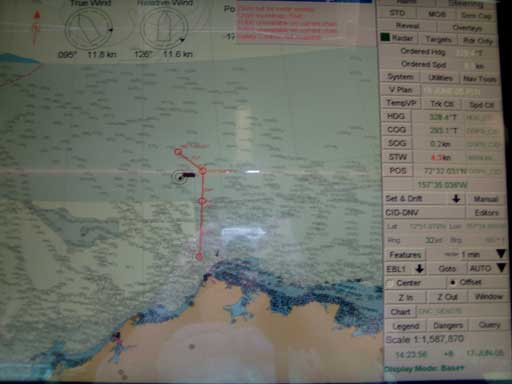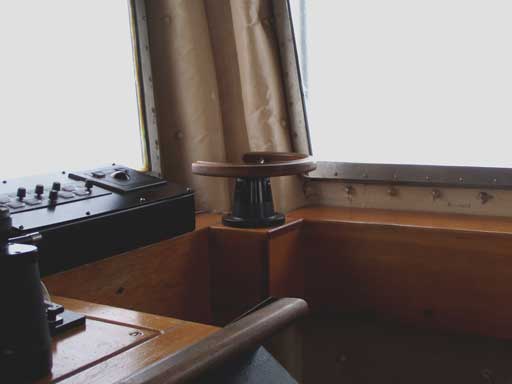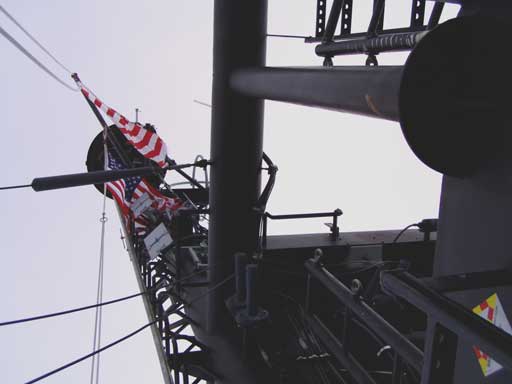( Log In ) Log In is for TREC Teachers & Researchers only
  |
| Steve_Marshall |
 Jun 18 2005, 04:22 AM Jun 18 2005, 04:22 AM
Post
#1
|
 TREC Teacher    Group: TREC Team Posts: 78 Joined: 27-April 05 Member No.: 12 |
6/15/05 #2
LIFE IS WHAT YOU MAKE OF IT As I mentioned to April in a reply to her question in the “Ask the Teacher….” section of this webpage, while things aren’t going exactly as planned, how you react to that is all a matter of attitude, and often a change in situations brings up new experiences equally valuable if you take a positive approach. Such was the case today. Since there’s not a lot that keeps people EXTREMELY busy when we’re not moving much, the atmosphere on the ship was even more laid back than it usually is. This allowed Lieutenant Commander Dalitsch of the operations department the opportunity to join a few of the science crew who were in the galley for a late night snack. We all spent a lot of time discussing our backgrounds, things about the Coast Guard, how life on this ship compares to other Coast Guard ships, and so on. Hearing everyone talk, it made me realize again what a great opportunity this trip is. It kind of amazes me when I think how close my earlier expectations (described in my journal entries after our orientation in Fairbanks) about how everyone would be working together and having their own valuable part to contribute based on each person’s unique background and experiences was comparing to the reality. Anyway, while we were finishing up this informative and enjoyable conversation with Lt. Cmd. Dalitsch, the ship’s navigator, BMSC Sullivan, invited us up to tour the bridge. He was going to be on the “night”watch for the bridge, so he wanted some help to stay awake. The Bridge Crew  Ship’s navigator BMSC Sullivan (pictured in the middle) with other members of the crew. One other interesting thing to note in this picture: The chair shown to the far right is the captain’s chair. While this ship seems more relaxed than most in the Coast Guard, one of the traditions they do hold is that NO ONE, other than the captain, sits in the captain’s chair…I think that’s understandable The navigator took time to go over many of the ships controls and instruments. It was amazing to see and hear about all the different types of equipment that is used and monitored to run the ship. I think what amazed me the most was the electronic mapping system they had. Before this system, navigation had to be done using numerous paper charts and compasses as shown here: Paper Charts and Compasses  This is the basic size of paper navigational charts. If a long cruise was planned, looking over numerous charts like these would be required, and the compass (the instrument on the map) would have to be used to manually plot the course. With the computer system, mapping can be done with touch-screen commands. The system has all the navigational charts stored digitally, and using your fingers to enter start and end points, the system would bring up the appropriate charts and plot the course. This information could then be sent to other ship systems, and the ship could practically steer itself based on the navigational information loaded into the system. This saves a lot of time since you don’t have to manually plot the course or work with bunches of bulky paper charts. Technological Advances  This system has digitized nautical charts rather than the paper kind. Pictured on the screen is the northern part of Alaska and our current position. If we wanted to plot a course, all we’d have to do is touch a few buttons and the spot where we wanted to go, and the computer would do all the necessary calculations to plot the course In addition to showing and explaining the technological aspects of the ship, Sullivan was also very open about life on the ship, and there was an emerging theme of how close this crew is and a philosophy of true team or family spirit where each was respected for their value and contribution to the operations of the ship. Skeptics may say we were hearing a bunch of public relations talk, but from what I’ve witnessed so far, I’d say the talk is as real as can be expected, and not a show. As one last treat for our tour of the bridge, we were allowed to go up to the “aloft conn,” the highest part of the ship that we were allowed to go (since everything higher is either a really small deck or an outside ladder on small pole, I don’t think I would WANT to go any higher!). The aloft conn is also the spot where the actual steering and navigation of the ship usually takes place. The view from this part was great, and what made it even more special was that by coincidence, we were at the highest point of the ship right at midnight. The significance of this is that we had the best view of the Arctic Ocean and the sun. At midnight, this meant that an imaginary line drawn from the sun to the horizon would be pointing due North (at noon, as similar line would point due south). At these times, we wouldn’t need any fancy computers to determine direction! The Aloft Conn  The highest three windows you see here (black surroundings) is the aloft conn. This is where most of the actual navigation/steering of the ship takes place. You Gotta be Kidding Me!  This is the view inside the aloft conn. The small steering wheel pictured here is what steers this huge ship. Amazing! Don’t Step Out Too Far!  An intern along with us on the cruise, Ray Savicke, takes a picture on the walkway that surrounds the outside of the aloft conn The Top of the Ship That’s on Top of the World  This is a picture of the ship’s tower, along with the U.S. and Coast Guard flags, taken from outside the aloft conn A Closer View of the Flags  Perfect Timing  Although it’s a little hard to see, you can definitely pick out the sun in this picture. This was taken from the aloft conn almost exactly at midnight, so this represents the closest point to the horizon the sun will get before getting higher in the sky again. Also at this point, a line drawn from the sun to the horizon indicates the “due north” direction. How Did We Get Here?  This is another view from the aloft conn. It seems that ice is thin and melting everywhere but where we are! After we climbed back down from the aloft conn area, we thanked the navigator for the great tour and experience. This gets back to what I started out saying at the beginning of this journal entry: Although our plans are a little delayed for conducting research, and although it’s not the most exciting thing being stuck in the ice, those circumstances opened new opportunities; If we were all busy doing our thing, we probably wouldn’t have had the chance to talk so in-depth with the ship’s crew. Additionally, we probably would have been so tired from working that our “midnight tour” of the bridge and aloft conn wouldn’t have been likely either. I found both of these opportunities to be very enriching experiences. I’m sure we will eventually get our samples and be able to do our research, but now we can add to it research and learning of an unexpected kind. Have a positive attitude and make the most of the circumstances handed to you…You won’t ever regret it. |
  |
2 User(s) are reading this topic (2 Guests and 0 Anonymous Users)
0 Members:

|
NSF Acknowledgment & Disclaimer | Time is now: 18th November 2024 - 02:20 AM |
Invision Power Board
v2.1.7 © 2024 IPS, Inc.








